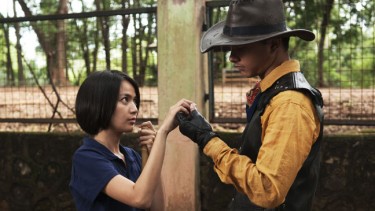 Back to selection
Back to selection
TRIBECA CRITIC’S NOTEBOOK #1: I WROTE THIS SONG FOR YOU, INDIEWOOD

How to take stock of the Tribeca Film Festival? 9/11 was a long time ago, after all. Bin Laden is dead. Rebuild the neighborhood, De Niro said. Bring back economic activity and all that. Perhaps the machinations of the real estate market took care of it. A classy sandwich down here costs $16. Not like I buy any food during the festival in Tribeca; it’s all free. Go to the Apple Store (in SoHo, but close enough) and have some wine. The 92YTribeca had bite-sized bacon cheeseburgers during GE’s-sponsored Film Forward shorts program yesterday. And if I actually want to see a movie, I go to Chelsea.
What we talk about when we talk about the Tribeca Film Festival has nothing to do with being, or not being, in the neighborhood, though. This ain’t about the Tribeca of Ghostbusters for instance, the squalid, misbegotten neighborhood where it was easy to find condemned fire stations in the summer blockbusters of yesteryear and easy for independent film companies to find office space and community a decade later. By the time I first came to New York, as a five-year-old with a protective black mother from the Midwest who gripped my hand extra tight when we crossed 30th Street, everyone in her sight in that city of 2,000 murders a year a potential danger, Ghostbusters 2 was just about to open, with its picture of a more sanitized New York than the one I would find on the streets outside the cinema, one I wouldn’t know was false until those streets taught me some things. If they ever do get around to making Ghostbusters 3, its stars long since eligible if not in need of Social Security, it will surely premiere at Tribeca.
Leaner and meaner was a theme for a while. No more 200-movie extravaganza with churches playing experimental films with live instrumentals, four simultaneous rooftop parties and Haile Gerima flicks from the ’70s, long since forgotten and restored at the behest of Martin Scorsese, to chose from. Perhaps it’s just quieter now, less catch-all, the potential of youth having given way to the reality of the film world? Fuck the B-listers. No more “Elliot Gould is still over-the-hill” movies. Tribeca has always had things for the layman and cinephiles, for the devoted and the merely curious or bored (or stupid). Slowly, over time, despite its often ungainly reputation, especially among status anxiety-driven New York filmmakers, it has acquired admirers. They don’t speak loudly. They whisper to each other in corners. People who, despite the bombast and the corporate largesse that underwrites it all (although perhaps there’s less largesse than there was before the emperors discovered they had no clothes, and we with them), unfailingly find both cinematic diamonds among the sprawl as well as the occasionally galling misstep that makes up the festival’s never boring if never truly great program. I count myself among them.
Very smart and capable individuals have always run the Tribeca Film Festival, even during its early, somewhat more chaotic and glamorous and oversized period. The festival’s initial Programming Director Peter Scarlet has long since fled to Abu Dhabi and his successor David Kwok to Berlin, but new Artistic Director Frederic Boyer‘s program is much the same as his predecessors in his first go at it, retaining many of the same assets and liabilities that have become the festival’s essential qualities since it began shrinking in the mid- to late-aughts from a gargantuan size to the 90 features and 60 shorts it now screens. While it’s still unwieldy, disadvantaged by its date in the calendar and not long for the neighborhood whose name it bears, where else in American independent film’s capital can one see such a large cross-section of off-the-beaten-track foreign features from top-shelf international fests, experimental narratives, new work from American doc auteurs and the occasionally overlooked American indie feature of some note?
Even if some just use Tribeca as an excuse to throw parties (any film festival could be accused of this I suppose, even if the party is just in a budget hotel room), there are always some fine movies on display too. Following up his lovely and oh-so-strange debut feature Blind Pig Who Wants to Fly, budding Indonesian Edwin’s candy-colored, largely irresistible Postcards from the Zoo (pictured above) is at once more accessible and otherworldly, as melancholy and oddly hopeful as his award-winning debut. The film tracks a young girl, abandoned by her parents in the Jakarta Zoo, who takes up shelter there with the small band of loyal zoo workers who become her surrogate caretakers. Soon she’s a fetching young adult with a special connection to this country of her own; hippos and one very special giraffe are her best friends until a dashing Indonesian cowboy with a penchant for magic enters her world. Not much later, after leaving the Zoo with her, he disappears mid-magic trick and she ends up becoming a massage-and-happy-endings girl for some two-bit pimp. Despite the turn toward grim settings, the movie never loses its sense of wonder, a unique and profound spirit of communion with the natural world which seems to inform Edwin’s wide eyed, heavily aestheticized aesthetic. This is the movie I was hoping Beasts of the Southern Wild would be.
David Redmon and Ashley Sabin’s Downeast, an at times lyrical and elusive documentary about the fishermen, factory workers, politicians and immigrant businessmen of Gouldsboro, Maine, a town that provides a fascinating microcosm for the difficulties of an American industry in these bleak times, is of a piece emotionally and aesthetically with their increasingly impressive body of work. Gouldsboro was the site of the country’s last sardine cannery and since it went out of business, its increasingly geriatric population has struggled to find work. Italian businessman Antonio Bussone attempts to turn it into a lobster processing plant, but the town’s board and several influential lobster fisherman attempt to stop him from tapping into federal relief funds in a series of scenes that are high on human interest though often don’t get to the heart of the local fiscal machinations that are at play as the plant opens but struggles to stay afloat. Still, the movie artfully shows us a picture of working-class, coastal New England that is frequently beautiful and honestly searching.

Less successful is Scott Thurman’s The Revisionaries. (Is that a word? Shouldn’t it be, The Revisionists?) Fascinating subject matter, though; anybody who read The New York Times Magazine piece on Don McLeroy and the Texas school board from February 11th, 2010 (as surely Mr. Thurman did, although he was probably making this movie by that point already) knows why. Texans should not control all of our textbooks! Duh. Mr. Thurman knows this, but the movie doesn’t do a very good job of presenting this essential truth, nor of making Mr. McLeroy or any of the other board members, the machinations which put them there and replace them, and the larger battle for the right to write history especially compelling or watchable. And it has terrible music. That’s a no-no.
 Daniel Schechter’s Supporting Characters surprised me. I was prepared to hate it. Excited to, even. It charmed the pants right off me. It might as well be TV, the way it’s shot (of course that means a lot less than it did ten years ago since TV is art now), and it couldn’t be more built to play Tribeca, but it’s genuinely written with feeling, humor and friendship that feels true and complicated. Newcomer Tarik Lowe and Alex Karpovsky have great chemistry as film editors doing a save job on a feature for a depressive director played by a never-less-than-terrific Kevin Corrigan. Although our Rosencrantz and Guildenstern’s optimism and good humor gives way to potential conflicts over future prospects and formulaic romantic trouble (Melonie Diaz’s character just ain’t that into Tarik; should Alex stay with good girl Sophia Takal or fuck the needy blonde movie starlets-to-be? These indeed, are questions to ask at the Tribeca Film Festival), the picture has a true lightness; it isn’t ambitious in any sense and does its best to be honest to its intentions and kind to its audience. It’s the last time you’ll ever see Lena Dunham as a supporting character, so hurry.
Daniel Schechter’s Supporting Characters surprised me. I was prepared to hate it. Excited to, even. It charmed the pants right off me. It might as well be TV, the way it’s shot (of course that means a lot less than it did ten years ago since TV is art now), and it couldn’t be more built to play Tribeca, but it’s genuinely written with feeling, humor and friendship that feels true and complicated. Newcomer Tarik Lowe and Alex Karpovsky have great chemistry as film editors doing a save job on a feature for a depressive director played by a never-less-than-terrific Kevin Corrigan. Although our Rosencrantz and Guildenstern’s optimism and good humor gives way to potential conflicts over future prospects and formulaic romantic trouble (Melonie Diaz’s character just ain’t that into Tarik; should Alex stay with good girl Sophia Takal or fuck the needy blonde movie starlets-to-be? These indeed, are questions to ask at the Tribeca Film Festival), the picture has a true lightness; it isn’t ambitious in any sense and does its best to be honest to its intentions and kind to its audience. It’s the last time you’ll ever see Lena Dunham as a supporting character, so hurry.
Jay Gammill’s Free Samples reminded me of why some people hate the Tribeca Film Festival. A lot of talented people were involved in making it, some who this journalist considers friends, others who I’ve long admired and some whose success and continued ascension into the ranks of film stars I find utterly baffling. No doubt no one will come to its critical rescue (except the most desperate and perhaps one of the festival honchos), although you may yet see it at a theater near you. I’m sure the movie has a very gifted sales agent. Stanford Law to ice cream saleswoman with a hangover and back into Jesse Eisenberg‘s lawyer arms (is he some kind of Texan in this movie — what’s with that hat?) — Jess Weixler is no Fassbinderian downwardly mobile case. It serves no one to slander it in our mostly friendly pages, but I would not recommend it to anyone, living or dead.
Andrew Semans‘ Nancy, Please ain’t bad at all. Waifishly thin on the narrative side (this is a movie about someone wanting to get a goddamn book back from his ex-roommate), it has winning performances (Rebecca Lawrence is easy to watch and all aces from Eléonore Hendricks, although like pretty much everything else she’s in, she’s underutilized) and some moments where it transcends its low budget, fairly typical indie style and crosses into something more arresting visually. The colorist on this one did a bang-up job. I wish it had reached farther though, had revealed stakes that were larger. It seems like it wants to for awhile, but then doesn’t have the courage of its convictions, the ingenuity to live out its promise. It’s not a film by someone who doubts he’ll ever make another and shouldn’t necessarily be, but it could use some of that urgency.
 James Franco‘s ongoing experimentation with the limits of his own celebrity are like little else popular culture has produced of late. While his hijinks within academia and beyond are well documented (he’s working on a Film MFA at NYU and an English PhD from Yale, while being a movie star, reediting My Own Private Idaho, writing essays for N+1 and occasionally doing some performance art with Laurel Nakadate), they come to a startling head in his Francophrenia (Or Don’t Kill Me, I Know Where the Baby Is), a daringly oddball collaboration with lauded documentarian Ian Olds, whose The Fixer: The Taking of Ajmal Naqshbandi was a hit in Tribeca in 2009. Seemingly lensed over the course of a one-night shoot, the film essentially follows Franco around the set of ABC’s General Hospital as he leers at people, engages in mind-numbing conversations, watches as mediocrity begets more mediocrity (what better form to behold banal storytelling than the daytime soap?), the camera fetishizing the massive amount of energy, individual industriousness and technological savvy being deployed in order to create something so mundane and slight.
James Franco‘s ongoing experimentation with the limits of his own celebrity are like little else popular culture has produced of late. While his hijinks within academia and beyond are well documented (he’s working on a Film MFA at NYU and an English PhD from Yale, while being a movie star, reediting My Own Private Idaho, writing essays for N+1 and occasionally doing some performance art with Laurel Nakadate), they come to a startling head in his Francophrenia (Or Don’t Kill Me, I Know Where the Baby Is), a daringly oddball collaboration with lauded documentarian Ian Olds, whose The Fixer: The Taking of Ajmal Naqshbandi was a hit in Tribeca in 2009. Seemingly lensed over the course of a one-night shoot, the film essentially follows Franco around the set of ABC’s General Hospital as he leers at people, engages in mind-numbing conversations, watches as mediocrity begets more mediocrity (what better form to behold banal storytelling than the daytime soap?), the camera fetishizing the massive amount of energy, individual industriousness and technological savvy being deployed in order to create something so mundane and slight.
Michael Winterbottom‘s Trishna, like so much of this startlingly talented director’s oeuvre, leaves me wanting. So sad, as there is much to love about his India-set, class consciousness-drenched retelling of Thomas Hardy‘s Tess of the D’Urbervilles. Largely undercut by the frequently underwhelming, seemingly wooden Frieda Pinto, it lacks the bite of Winterbottom’s best work and of Hardy’s source novel. You don’t understand why this lower-caste girl is so taken with her initially charming but ultimately dismissive and unfeeling benefactor/boyfriend that she would destroy them both. Icarus in this case should have known not to fly so close to the sun. Still, Winterbottom is one of the world’s most underappreciated stylists, having refined the kineticism one might associate with the work of MTV auteurs and Michael Bay into his own form of mediated, montage-driven hyper-realism.
I honestly don’t remember much of Justin Benson and Aaron Scott Moorhead’s unnecessarily convoluted and self-reflexive Resolution and that’s probably for the better. One character kidnaps another, who happens to be his best friend, drags him out to a small house on an Indian reservation and chains him to a pipe so he’ll quit dope and sober up. And then everything starts getting metaphysical and some white-boy gangbangers with bad intentions show up. I can’t remember when or even why I lost interest. Surely at some point I fell asleep, or checked the time on my phone, wondering who was out there, wanting to get a hold of me or simply got annoyed by the guy in the trucker hat who’s locked to the pipe or some combination thereof. By the time what has traditionally been known in cinema as an exposure mistake becomes intentionally used by the filmmakers within the film to clue the characters that they’re in a movie (and the audience that they’re watching one), I was too foolish not to leave. You’ll never know how much grief that may have saved me.
